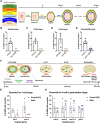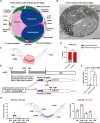This is a preprint.
Mechanical force of uterine occupation enables large vesicle extrusion from proteostressed maternal neurons
- PMID: 38014134
- PMCID: PMC10680645
- DOI: 10.1101/2023.11.13.565361
Mechanical force of uterine occupation enables large vesicle extrusion from proteostressed maternal neurons
Update in
-
Mechanical force of uterine occupation enables large vesicle extrusion from proteostressed maternal neurons.Elife. 2024 Sep 10;13:RP95443. doi: 10.7554/eLife.95443. Elife. 2024. PMID: 39255003 Free PMC article.
Abstract
Large vesicle extrusion from neurons may contribute to spreading pathogenic protein aggregates and promoting inflammatory responses, two mechanisms leading to neurodegenerative disease. Factors that regulate extrusion of large vesicles, such as exophers produced by proteostressed C. elegans touch neurons, are poorly understood. Here we document that mechanical force can significantly potentiate exopher extrusion from proteostressed neurons. Exopher production from the C. elegans ALMR neuron peaks at adult day 2 or 3, coinciding with the C. elegans reproductive peak. Genetic disruption of C. elegans germline, sperm, oocytes, or egg/early embryo production can strongly suppress exopher extrusion from the ALMR neurons during the peak period. Conversely, restoring egg production at the late reproductive phase through mating with males or inducing egg retention via genetic interventions that block egg-laying can strongly increase ALMR exopher production. Overall, genetic interventions that promote ALMR exopher production are associated with expanded uterus lengths and genetic interventions that suppress ALMR exopher production are associated with shorter uterus lengths. In addition to the impact of fertilized eggs, ALMR exopher production can be enhanced by filling the uterus with oocytes, dead eggs, or even fluid, supporting that distention consequences, rather than the presence of fertilized eggs, constitute the exopher-inducing stimulus. We conclude that the mechanical force of uterine occupation potentiates exopher extrusion from proximal proteostressed maternal neurons. Our observations draw attention to the potential importance of mechanical signaling in extracellular vesicle production and in aggregate spreading mechanisms, making a case for enhanced attention to mechanobiology in neurodegenerative disease.
Conflict of interest statement
DECLARATION OF INTERESTS The authors declare no competing interests.
Figures







Similar articles
-
Mechanical force of uterine occupation enables large vesicle extrusion from proteostressed maternal neurons.Elife. 2024 Sep 10;13:RP95443. doi: 10.7554/eLife.95443. Elife. 2024. PMID: 39255003 Free PMC article.
-
Stress increases in exopher-mediated neuronal extrusion require lipid biosynthesis, FGF, and EGF RAS/MAPK signaling.Proc Natl Acad Sci U S A. 2021 Sep 7;118(36):e2101410118. doi: 10.1073/pnas.2101410118. Proc Natl Acad Sci U S A. 2021. PMID: 34475208 Free PMC article.
-
Intermediate filaments associate with aggresome-like structures in proteostressed C. elegans neurons and influence large vesicle extrusions as exophers.Nat Commun. 2023 Jul 24;14(1):4450. doi: 10.1038/s41467-023-39700-1. Nat Commun. 2023. PMID: 37488107 Free PMC article.
-
Large vesicle extrusions from C. elegans neurons are consumed and stimulated by glial-like phagocytosis activity of the neighboring cell.Elife. 2023 Mar 2;12:e82227. doi: 10.7554/eLife.82227. Elife. 2023. PMID: 36861960 Free PMC article.
-
Egg-laying.WormBook. 2005 Dec 14:1-7. doi: 10.1895/wormbook.1.38.1. WormBook. 2005. PMID: 18050396 Free PMC article. Review.
References
-
- Cooper J.F., Guasp R.J., Arnold M.L., Grant B.D., and Driscoll M. (2021). Stress increases in exopher-mediated neuronal extrusion require lipid biosynthesis, FGF, and EGF RAS/MAPK signaling. Proceedings of the National Academy of Sciences of the United States of America 118. 10.1073/pnas.2101410118. - DOI - PMC - PubMed
-
- Arnold M.L., Cooper J., Androwski R., Ardeshna S., Melentijevic I., Smart J., Guasp R.J., Nguyen K.C.Q., Bai G., Hall D.H., et al. (2023). Intermediate filaments associate with aggresome-like structures in proteostressed C. elegans neurons and influence large vesicle extrusions as exophers. Nat Commun 14, 4450. 10.1038/s41467-023-39700-1. - DOI - PMC - PubMed
Publication types
Grants and funding
LinkOut - more resources
Full Text Sources
